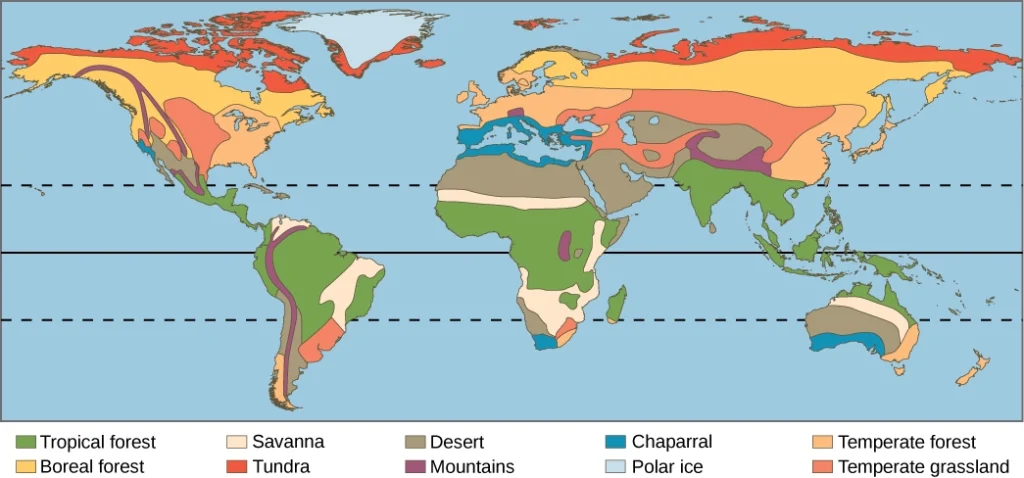
What is a Biome?
Biomes, also known as a major life zones, are areas that comprises communities of plants and animals that have a common adaptation to that specific environment. It is the biggest geographic biotic unit that contains various communities that are named after the leading features of that region – like terrestrial biome and aquatic biome. Terrestrial biomes consist of grasslands, deserts, and tropical forests.
Freshwater biomes contain polar freshwaters, large lakes, tropical and sub-tropical coastal rivers, temperate coastal rivers, and much more. Marine biomes comprise continental shelves, tropical coral, and kelp forests. At times, the boundaries between biomes merge, such an intermediate area is called an ecotone. For example, riparian areas and salt marshes.
Within each biome, there is a change in temperature and weather conditions, and some organisms are adapted to only part of the biome while others are adapted to the full variety of conditions within the boundaries defined.
Tropical Rainforest
Tropical rainforest stays warm all year. There are too many animals and the huge numbers of trees keep their leaves around the year. The tropical forests get so much rain that there isn’t even much of a dry season, more like a rainy season and a rainier season. The majority of tropical rainforests are located in four biogeographic regions:
- The Afrotropical (mainland Africa, Madagascar, and scattered islands)
- The Australian (Australia, New Guinea, and the Pacific Islands)
- The Indomalayan (India, Sri Lanka, mainland Asia, and Southeast Asia), and
- The Neotropical (South America, Central America, and the Caribbean islands
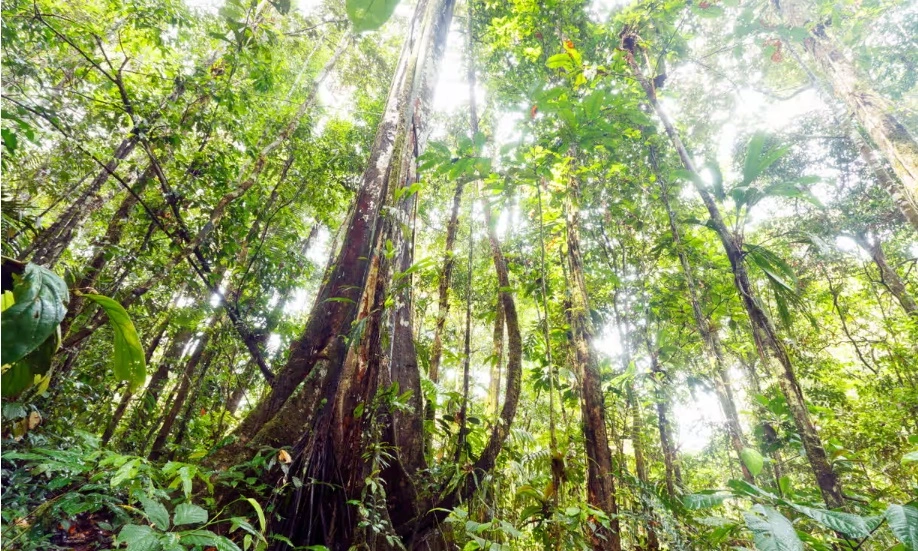
The tropical rainforest is a hot, moist biome where it rains all year. This type of forest is known for its dense canopies of vegetation that form three different layers. The top layer contains huge trees that grow to heights of 75 m or more. This layer prevents much of the sunlight from reaching the ground. Thick, woody creepers are also found in the canopy. They climb trees to the canopy to reach for sunlight. The middle layer is made up of vines, smaller trees, ferns, and palms.
A large number of plants from the middle layer are used as common houseplants. Because of the small amount of sunlight and rain these plants obtain, they adapt easily to home environments. The bottom layer of the rainforest is covered with wet leaves and leaf litter. This layer decomposes rapidly in wet, warm conditions sending nutrients back into the soil.
Temperate Forest Biomes
This kind of forest has relatively four distinct seasons. Many of the trees shed their leaves in the fall and become sedentary through the cold winter. In these forests, the fauna found are deer, woodpeckers, and bears, some of which hibernate through the winter.
Regions of the world where it’s not extremely hot or cold are called temperate regions, the forests are full of trees with wide, thin leaves. Leaves absorb sunlight during the summer. But when the days start getting shorter in the winter, the leaves become dry, change color, and ultimately drop off the trees. Trees that shed their leaves in winter are called deciduous trees.
Some temperate forests have trees with needles instead of leaves. Trees that have needles and cones are called conifers. A forest with typically conifers is called a coniferous forest. They are evergreen plants. Pines, firs, and spruce trees are examples of conifers and also Christmas trees. A forest having both deciduous and conifers is called a mixed forest.
Desert Biomes
Deserts form the hottest biome, but can also have cold temperatures in winter. Such temperature fluctuations make this an extreme environment, where many animals have to dig tunnels to find more stable temperatures to survive. Plants and animals here must be able to survive for a long period without water. The temperature in the desert can change significantly from day to night because the air is so dry that heat escapes quickly at night. The daytime mean temperature is 38°C while in some deserts it can go down to -4°C at night.
Tundra Biomes
Tundra is plain and cold with small plants like grass and moss that only grow during the short summer. A thick layer of ice lies below the shallow soil of the permafrost all year round, and trees cannot enter it to anchor their roots. Many birds visit the tundra biome in the summer to nest, but most escape in the winter migrating to warmer areas. Mice and other small mammals stay lively during the winter in protected tunnels under the snow.
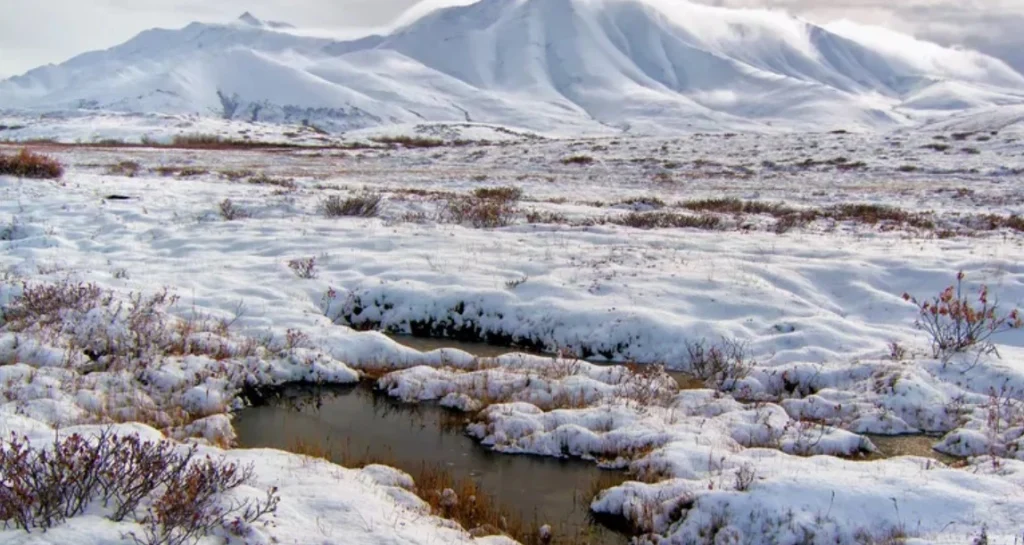
Tundra is plain and cold with small plants like grass and moss that only grow during the short summer. A thick layer of ice lies below the shallow soil of the permafrost all year round, and trees cannot enter it to anchor their roots. Many birds visit the tundra biome in the summer to nest, but most escape in the winter migrating to warmer areas. Mice and other small mammals stay lively during the winter in protected tunnels under the snow.
Taiga/ Boreal Forest Biomes
The boreal forest covers approximately 11% of Earth’s land mass. Taiga is the largest land terrestrial biome in the world located in the northern hemisphere. The term “boreal forest” refers to the southern part of the biome. The term “taiga” refers to the northern part of the biome.
It is made up of mostly conical-shaped evergreen trees having needle-like leaves. These trees are called conifers because their seeds are stamped into cones. In long cold winters, most mammals hibernate and birds migrate in the taiga/ boreal forests. Animals like weasels, rabbits, and grouse, which do not migrate or hibernate, grow dense feathers or fur and turn white to camouflage with the snow.
It also has many freshwater ecosystems including streams, rivers, lakes, ponds, bogs, fens, and marshes. The soil in this biome is less fertile. This soil is also acidic. Annual temperatures range from 21 °C in summer to -54 °C in winter. Rainfall in this biome is moderate and ranges from 200 to 600 mm per year. Plants in this biome have adapted to the cold climate and poor soil. Many of the plants have shallow roots.
Grassland Biomes
Grasslands are almost completely short to tall grasses with no trees. This land type receives just enough rain to help grasses, flowers, and herbs grow but stays dry enough that fires are common and trees cannot survive. Large mammals that often travel together in huge herds are found here.
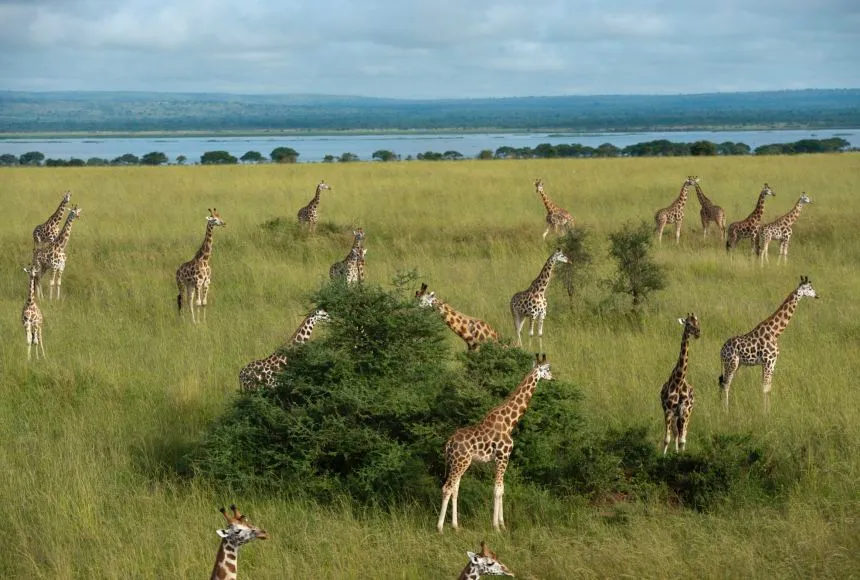
The grasslands are further divided into, 1) Tropical Grasslands – also known as the Savanna or savannah. They are considered as the combination of broadly spaced grassy fields and woodlands where enough light reaches the ground. Annually, rainfall is 30 to 50 inches, which is then followed by a dry season. 2) Temperate Grasslands –similar to tropical grasslands, except it has warm summers followed by cold winters. Average annual precipitation ranges between 30 and 35 inches. The temperate grasslands are subdivided into Steppes and Prairies. Prairies have tall grasses and Steppes have grasslands with moderately short grasses.
Savannah is tree-studded grasslands that obtain enough seasonal rainfall so that trees can grow in open groups or singly throughout. The animals living here have long legs for dodging predators and usually are seen in herds. A combination of fire and grazing animals is important for sustaining the savannah.
Aquatic Biomes
Water maintains many lives. Organisms that live in water are called aquatic organisms. Such organisms depend on water for their food, shelter, reproduction and all other activities necessary for life. An aquatic biome includes a group of interrelating organisms that are dependent on one another and the water environment for nutrients and shelter. Examples of aquatic ecosystems include oceans, lakes, and rivers. It includes freshwater habitats like lakes, rivers, oceans, ponds, streams, wetlands, and, swamps, etc., and marine habitats include oceans, reefs, intertidal zone, seabed, etc.
Freshwater
They cover only nearly 0.8 percent of the Earth. Freshwater habitats are categorized into lotic and lentic habitats. Water bodies for example lakes, ponds, bogs, pools, and other reservoirs are standing water and known as lentic habitats. Whereas lotic habitats signify flowing water bodies such as rivers, and streams.
Lotic Ecosystems
They mostly refer to the rapidly flowing waters that move in one direction including the rivers and streams. These environments possess numerous species of insects such as beetles, stoneflies, mayflies, and several species of fish including trout, eel, minnow, etc. Apart from these species, this habitat also includes various mammals such as beavers, river dolphins, and otters.
Lentic Ecosystems
They comprise all standing water habitats. Lakes and ponds are the key examples of the Lentic Ecosystem. The word lentic mainly refers to stationary or comparatively still water. These ecosystems are home to algae, shrimps, crabs, amphibians such as salamanders, and frogs, for both rooted and floating-leaved plants and reptiles comprising alligators and other water snakes are also found here.
Wetlands
Wetlands are marshy areas and are occasionally covered in water which has an extensive diversity of plants and animals. Swamps, bogs, marshes, black spruce, and water lilies are a few examples of plant species found in the wetlands. The animal life consists of dragonflies and damselflies, birds such as Green Heron, and fishes (Northern Pike).
Marine Biomes
It covers the largest surface area of the earth. Two third of the earth is covered by water in oceans, seas, intertidal zones, sea beds, reefs, estuaries, rock pools, and, hydrothermal vents. Each life form is unique and innate to its habitat because of adaptations according to its habitat. If we talk about aquatic animals, they can’t survive outside of water.
Extraordinary cases are still there which shows another example of adaptations for example mudskippers. The marine ecosystem is concentrated with salts which make it challenging for freshwater organisms to live in. Also, marine animals cannot live in freshwater. These animals have the body adapted to live in saltwater if they are placed in less salty water, their body will swell.
Ocean Ecosystems
Planet Earth is gifted with five major oceans, namely the Indian, Pacific, Arctic, and Atlantic Ocean. Among all these, the Pacific and the Atlantic are the largest and deepest oceans. These oceans serve as a home to more than half a million aquatic species. Some creatures of these ecosystems include shellfish, sharks, tube worms, crabs small and large ocean fishes, turtles, crustaceans, blue whales, reptiles, marine mammals, seabirds, plankton, corals, and other ocean plants.
Coastal Ecosystems
They are the open systems of land and water that are combined together to form coastal ecosystems. The coastal ecosystems have a different organization and diversity. An extensive variety of species of aquatic plants and algae are found at the bottom of the coastal ecosystem. The animals are diverse and it mainly consists of crabs, fish, insects, lobsters snails, shrimp, etc.
 The Climent Respect your roots, Protect your planet
The Climent Respect your roots, Protect your planet
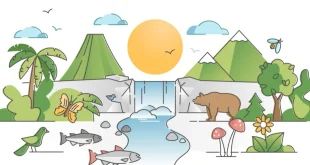
5 comments
Pingback: Exploring the Importance of Ecotones in Biodiversity Conservation - The Climent
Pingback: Grassland: A Comprehensive Guide to the 2 Major types of Grasslands - The Climent
Pingback: Wetland Wonders: A Closer Look at Their Unique Types and Importance - The Climent
Pingback: Desert Ecosystem: Major Components and Importance of Desert Ecosystem - The Climent
Pingback: Fascinating Facts About Rangelands You Need to Know - The Climent